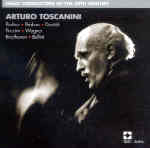EMI has managed to complete its Great Conductors of the 20th Century series without including Mengelberg and Bernstein among a chosen 40 that found room for Malko and Coates. Few would dare contest Toscanini’s place in the podium Pantheon, and even if his later career has been documented many times over, EMI has come up with an interesting overview. Toscanini buffs, like Furtwängler fans, have an inexhaustible capacity for absorbing–and making minute comparisons among–the conductor’s multiple performances of a given work. So even if there’s only one item here they don’t already have, they’ll feel the need to own this set. Other collectors likely will be satisfied with long-available Toscanini-led alternatives of the key works offered here since they’re in better sound, and even if the interpretive differences aren’t of the earth-shaking variety, they do counter the common belief that he was always too fast and rigid.
This Beethoven Sixth, for example, a 1937 recording with the BBC Symphony, is notable for being more relaxed than the conductor’s 1952 NBC reading. The rubato is freer, the strings glow with warmth in the Andante. But the opening stroll in the woods is still a brisk jaunt, no stopping to pick the wildflowers, and for Toscanini the last movement’s Shepherd’s hymn of thanksgiving is just an Allegretto (more like an Allegro here), if a less tense one than on his later recording. The Brahms’ Fourth, a 1948 broadcast from the notorious Studio 8H, is one of four Toscanini versions I’ve heard, and I agree with Mortimer Frank’s booklet notes that it is “perhaps his finest surviving account of the work.” As usual with Toscanini, transparency and detail are paramount, but there’s also a timbral warmth and rhythmic freedom not always present in his later efforts.
Toscanini’s operatic mastery is present in several selections, most importantly in the live 1941 Carnegie Hall Götterdämmerung Immolation Scene, with Helen Traubel as a laser-voiced Brünnhilde, singer and orchestra thrilling, more “alive” than in their studio version. The opening chorus from Norma flows beautifully, less stately and with more rhythmic lift than it usually gets. Dvorák’s Symphonic Variations is neatly done. The fillers, a 1944 Intermezzo from Puccini’s Manon Lescaut, Berlioz’s Francs-Juges Overture from 1941, and Wagner’s Rienzi Overture from 1938, all with the NBC Symphony, must have been wonderful live, but are compromised by restricted, unflattering sound.
































